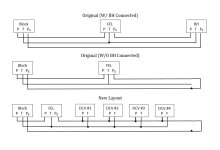J_J
Super Star Member
- Joined
- Sep 6, 2003
- Messages
- 18,952
- Location
- JACKSONVILLE, FL
- Tractor
- Power-Trac 1445, KUBOTA B-9200HST
A CC valves blocks the hyd flow and causes the fluid to pass through a relief valve upstream as most solenoid valves no not have relief valve.
An open center hyd system uses a gear pump to pump fluid and the fluid is always moving.
How long has the valves been installed?
If you need solenoid valves for remotes, then select the open center valves.
If you want to read the pressure for any part of the system, install the gage in a tee in the IN port of the first valve. Then anytime you use a valve, the gage will reflect the pressure developed by that circuit.
However as in the other post about relief valve, the lowest valve relief setting will limit the pressure.
If you remove those CC valves and connect the PB hose from the FEL to the 3pt, you should be back to normal operation.
How long have you had those valves? Maybe Northern will exchange them for you.
An open center hyd system uses a gear pump to pump fluid and the fluid is always moving.
How long has the valves been installed?
If you need solenoid valves for remotes, then select the open center valves.
If you want to read the pressure for any part of the system, install the gage in a tee in the IN port of the first valve. Then anytime you use a valve, the gage will reflect the pressure developed by that circuit.
However as in the other post about relief valve, the lowest valve relief setting will limit the pressure.
If you remove those CC valves and connect the PB hose from the FEL to the 3pt, you should be back to normal operation.
How long have you had those valves? Maybe Northern will exchange them for you.


